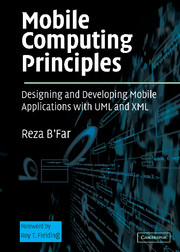Book contents
- Frontmatter
- Contents
- Foreword by Roy T. Fielding
- Acknowledgments
- SECTION 1 INTRODUCTIONS TO THE MAIN TOPICS
- Chapter 1 Introduction to Mobile Computing
- Chapter 2 Introduction to Mobile Development Frameworks and Tools
- Chapter 3 XML: The Document and Metadata Format for Mobile Computing
- Chapter 4 Introduction to UML
- SECTION 2 DEVICE-INDEPENDENT AND MULTICHANNEL USER INTERFACE DEVELOPMENT USING UML
- SECTION 3 ADDITIONAL DIMENSIONS OF MOBILE APPLICATION DEVELOPMENT
- SECTION 4 PUTTING THE PROJECT TOGETHER
- References
- Index
Chapter 3 - XML: The Document and Metadata Format for Mobile Computing
from SECTION 1 - INTRODUCTIONS TO THE MAIN TOPICS
Published online by Cambridge University Press: 03 September 2009
- Frontmatter
- Contents
- Foreword by Roy T. Fielding
- Acknowledgments
- SECTION 1 INTRODUCTIONS TO THE MAIN TOPICS
- Chapter 1 Introduction to Mobile Computing
- Chapter 2 Introduction to Mobile Development Frameworks and Tools
- Chapter 3 XML: The Document and Metadata Format for Mobile Computing
- Chapter 4 Introduction to UML
- SECTION 2 DEVICE-INDEPENDENT AND MULTICHANNEL USER INTERFACE DEVELOPMENT USING UML
- SECTION 3 ADDITIONAL DIMENSIONS OF MOBILE APPLICATION DEVELOPMENT
- SECTION 4 PUTTING THE PROJECT TOGETHER
- References
- Index
Summary
It is God whom every lover loves in every beloved!
Al ArabiINTRODUCTION
The Extensible Markup Language—XML—is a subset of the Standard Generalized Markup Language (SGML) specified in ISO standard 8879. SGML was created to create and maintain complex and portable documents to be used in highly scalable systems in a nonproprietary manner to any particular vendor. XML has become a key technology in the development of content for the World Wide Web. Today, with the birth of Web services, it is used for more than its original purpose of representing documents.
There are many excellent writings and books on the topic of XML. If you are not familiar with XML, you should probably stop here, familiarize yourself with the basics of XML, and then come back and continue. In this chapter, our intent is to outline some XML-based or XML-related technologies that are key in developing mobile applications.
To understand how and why XML is used in mobile applications, we should understand a brief history of how it came to be.
Brief History
In the beginning, there was SGML. And then, from SGML, came the less intelligent, but more likable son, XML.
If there were a bible of computer science, it would tell us the history of XML with a bit more flare. But, that essentially sums up where XML came from.
When the Web was first created, XML's sister, HTML, was born first.
- Type
- Chapter
- Information
- Mobile Computing PrinciplesDesigning and Developing Mobile Applications with UML and XML, pp. 104 - 154Publisher: Cambridge University PressPrint publication year: 2004



